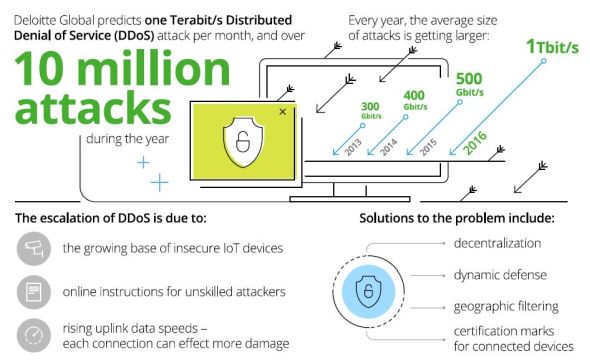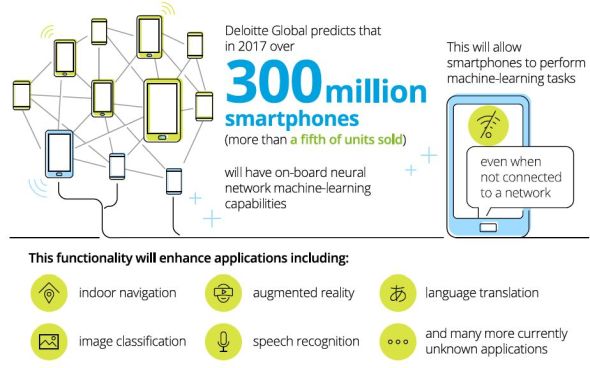Breakthrough in machine learning, growing use of biometric security, escalation in DDoS attacks and half a trillion global spend on IT-as-a-Service are some of the key predictions for 2017.
Deloitte released their 16th edition of predictions for the Technology, Media and Telecommunications (TMT) sectors. These insights are based on original and secondary research, perspectives gained from hundreds of conversations with industry leaders, and the aggregated opinions of tens of thousands of consumers around the world.
Key global predictions for 2017 include:
Biometric security reaches the billions
As the ubiquity of the fingerprint reader grows, Deloitte expects a growing proportion of apps and websites to support this technology, primarily as an alternative to password entry and, fingerprint reader-equipped devices will top one billion for the first time in 2017.
Today, one in three Australians has a fingerprint scanner on their smartphone for security purposes. Biometric applications will expand into areas such as providing identification for online Australian government services, building security and eWallet payments.
IT-as-a-Service: the half trillion dollar ‘niche’
Worldwide spending on ITaaS will be reach $US550 billion worldwide as more and more enterprises understand the benefits of a predictable, consumption-based expense model which can be easily scaled up or down to suit changing business needs.
The Australian experience is consistent with the global trend. Asia Pacific IT consumption models are also growing, driven by growth in consumer and small-business adoption.
DDoS attacks enter the terabit era and Australian IoT devices
Distributed Denial-of-Service (DDoS) attacks will become larger in scale, harder to mitigate (increasing the severity of impact) and more frequent. There will be on average one terabit/s attack per month, over 10 million attacks and an average attack size of 1.25 to 1.5 gigabits per second of junk data being sent.
Australia has the fifth highest level of web application attacks in the world, and according to the Australian Government’s Cyber Security Strategy, cybercrime costs Australia $AU17 billion annually. Australian businesses will need to implement multi-dimensional and dynamic strategies to mitigate the risk of DDoS.

Machine learning goes mobile
More than a fifth of smartphones sold in 2017, will have on-board neural network machine learning capability. They will allow smartphones to perform machine learning tasks (including indoor navigation, speech recognition and language translation) even when not connected to a network.
Machine learning is paving the way for a unique era in functionality and personalisation, enabling us to have a personalised computer in the form of a smart phone in our hands.

The great indoors: the final frontier for digital navigation
By 2022, at least a quarter of all human and machine uses of digital navigation will include an indoor component or be for an entirely indoor journey. Over the next decade, this will have the same disruptive impact as outdoor navigation and will enable new business models and improve existing ones.
In Australia, there has been quick adoption amongst retailers and shopping centres, as a counter to the personalised shopping experience that was, thus far, the forte of online retailers such as Amazon.
Tablets may peak
The report predicts a 10 percent decline in tablet sales globally in 2017. Their position as the device filling the gap between laptops/desktops and smartphones have been squeezed by smartphones getting bigger and laptops becoming lighter.
Australia has also seen a declining interest in tablets, partly attributed to improvements in mobiles and computers.
5G: a revolution in evolution
Deloitte predicts that up to 200 global carriers, representing tens of millions of customers, will be able to access 100Mbit speeds this year as the next generation of mobile networks is developed. The change will be felt in a series of interim steps before we see standardisation, deployment and commercial uptake of 5G.
In Australia, most handsets sold since 2016 include the capability to access this type of network enabling high speeds.
The road to self-driving starts with automatic braking
A sixth of US cars and light trucks will be equipped with automatic emergency braking (AEB) technologies and this will be the single greatest factor contributing towards a 16 percent reduction in annual motor vehicle deaths.
In Australia, the Australasian New Car Assessment Program (ANCAP) says that AEB has been shown to reduce rear-end crashes by more than 38%. Within the next decade, it is likely that AEB will become mandatory on Australian roads.
To learn more about Deloitte and the TMT predictions, visit www.deloitte.com.
For strategic insights on how these trends can disrupt or offer growth opportunities for your organisation, contact the blueAPACHE team.

